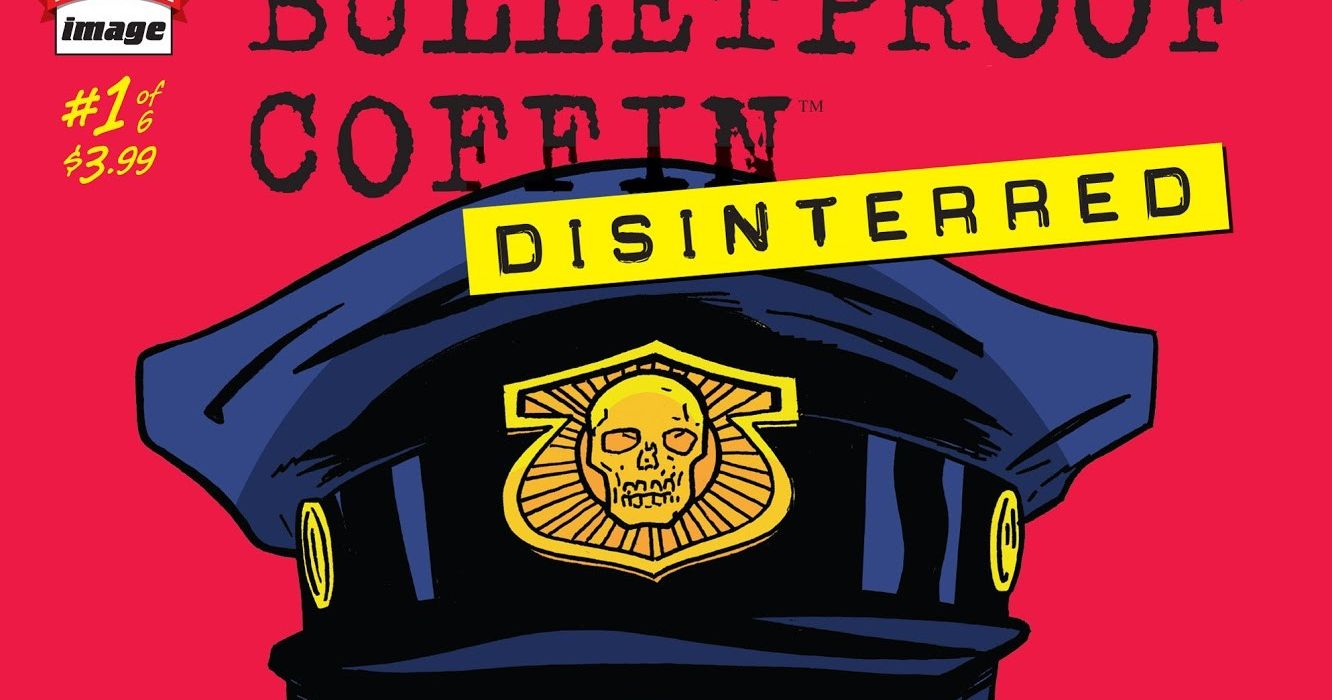the play is the tragedy, “Man,” and its hero, the Conqueror Worm.
Written by David Hine, illustrated by Shaky Kane, lettered by Richard Starkings and Comicraft’s Jimmy BetancourtCover by Shaky Kane
Back from the grave! The cult hit of 2011 returns with a tale of treachery, murder and unrequited lust. When headless corpses start to appear on the first night of the full moon, ace detective Johnny P. Sartre smells a rat…Contains profanity, nudity, violence and the graphic depiction of alcohol abuse.
The first “Bulletproof Coffin” series was rather straightforward. Sure it was weird, in that David Lynch-ian way, but you could map the events from A to B and maybe point at the genre it was pretending to play in. It was a metafictional self-commenting work of the type that is very popular in the self-identifying cerebral circles of cape comics fans.
“Disinterred,” its semi-sequel, I recall as being genuinely as out there as a comic-book can get without floating out off the walls of reality and breaking into some hitherto unknown dimension inhabited only by the cosmic conscious of Jack Kirby’s lost ideas. A series of one-shot stories aping both various genres and moods of expression from different ages of pop-culture; mostly held together by stylistic glue that only David Hine and Shaky Kane can provide while hopping around from idea to an idea in free-flowing manner. It was like jazz improvisation, only not really like that at all. In order to preserve the original feel of reading that series I’m commenting on these issues right after I read each of them, without really recalling what comes next and with minimal self-editing.
Issue one starts the ball rolling by constantly teasing its readers. a man crawls out of a sewer in the midst of a graveyard, only to have his head blasted off by a pair of superheroes that were leading figures in the previous miniseries. We’re thrown right into the thick of things with no time spent on introduction, and whenever we become sure we’ve got things figured out the comics slaps us in the face. We think it’s about this random guy but he gets bumped off, we think it’s about these two wild-looking superheroes but they simply walk off the page never to return (in this issue at least).
Only then we get the actual protagonist, or the thing closest to it, in this story: a hardboiled-detective type called Jonny P. Sartre that thinks in the most awesome post-Jim Thompson pre-Frank Miller caption boxes (“Moon-lit guys spilling like black eels from ruptured bellies of drunks in back ally knife fights”). Detective Sartre investigates a series of murders characterized by a missing head replaced each time with some disturbing memento (an octopus, an old TV set and, of course, a mirror). It’s all very much in the mold of Se7en, but filtered through the prism of pop-culture. The randomly headless body in the graveyard ruins the patterns, we know it was all just a stupid mistake but the police does not, and the detective is cast adrift in his own case. Confused by this new pattern he ends up diving head first into paranoia.
The comics asks us to make connections, offers us vague ideas and notions, but withholds any solution, or even the possibility of making one. The world is chaos. Our detective hero is a forceful personality, determined to force the world to make sense. Since I’ve mentioned Frank Miller previously it’s hard to forget that one line from “The Dark Knight Returns” that seemingly sums up his whole philosophy – “[My dead parents] showed me the world only make sense when you force it to…” but in this comics the world refuses to make sense.
In his attempt to connect all the dots Detective Sartre (is the name meaningless in any way? Or is it another joke the creators pull on the readers? Or is both at the same time?) becomes convinced his partner, which he lusts over in a series of fantasy segues that casts them both as another pair of superheroes, is the killer. What’s more – he believes he’s to be the final victim and his murder will complete the pattern of a pentagram the killer tries to draw upon the city.
This recalls “From Hell” by Alan Moore and Eddie Campbell, in which another killer draws an image of pentagram upon a city in a series of murders that are justified in philosophically-dense conversations between the killer and his assistant. The conversations in “From Hell” are genuinely impressive in their historical and philosophical reach while being complete and utter misogynistic nonsense. This is, partially at least, the point. In both of these stories men find reasons to distrust women, to kill women, and to justify it intellectually in their confessions. In that they are dependents of Lolita’s protagonist Humbert Humbert, the type men who can intellectualize their worst actions with endless verbiage that sounds just clever enough to make most listeners forget they are just plain misogynists.
It would be a reach to tie-down “The Killer Inside” as deconstruction of toxic manhood, just it would be a mistake to try and tie it down to any single subject. This is what leaped at me during this reading – the idea of the superhero as something men escape to assume control. This escapist fantasy, the story seems to say, is not very different from the model of tough-guy detective. The title of this issue seems to be a nod for the novel The Killer Inside Me by crime-writer Jim Thompson. Thompson wrote the kind of protagonists that were to the classic detectives what the cast of “Watchmen” was to classic superheroes. they were the sad truth hiding underneath the ideals. And as we close this first issue with a man literally escaping into an illusion we must return to the opening scene: something, someone, rising from his grave. Exhumed. unearthed. Disinterred.







